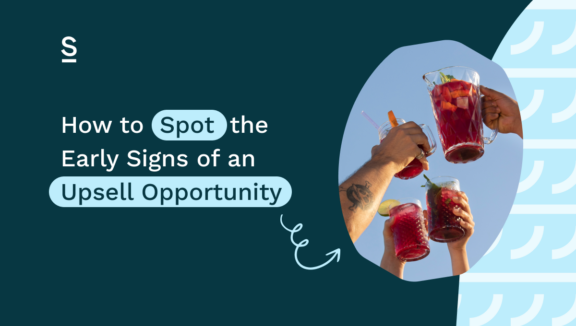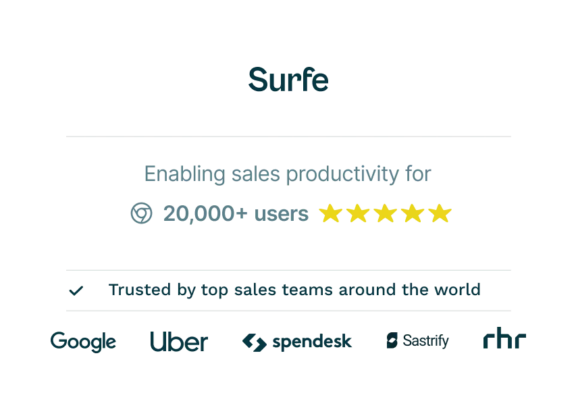How to Spot the Early Signs of an Upsell Opportunity

Let’s pretend you’re at a fairground.
You see a stuffed animal that you really, really want to win.
But so does somebody else. That’s not going to happen – that prize is yours.
Now, a normal person might just dive into the game without any preparation and hope for the best. But you’re not a normal person. No offense.
You’re going to do everything in your power to maximize your chances of taking that stuffed animal home: planning your strategy before you start, scouting out opportunities to gain the upper hand, getting the timing right…
Thanks for bearing with us on that one. You see, upselling – selling additional or upgraded products to existing customers – is a bit like that. To pitch an upsell successfully, you need to understand why you’re pitching and how you’re going to close it. Do this successfully, and you’ll enjoy greater customer lifetime value, deeper customer relationships, and increased revenue without increasing acquisition costs.
Identifying upsell opportunities early is an important part of the process and can significantly increase your chances of success. And this blog post is going to teach you to do just that:
- Early Signs of an Upsell Opportunity: Customer Satisfaction and Engagement
- Product Utilization: Spotting Gaps in Usage
- Data-Driven Insights: Using KPIs to Identify Upsell Opportunities
- Building the Relationship: When and How to Introduce the Upsell
Ready? Let’s get started.
Why Upselling Is Critical for Business Growth
Before we get into it: why is upselling so impactful?
In short, upselling increases revenue. It makes the value of each sale bigger and improves retention by meeting customers’ needs – which, with time, are going to change.
Current customers spend on average 67% more than new customers – which becomes all the more impressive when you consider that acquiring a new customer can cost up to 25 times more than keeping an existing one on the books. That’s basically a double whammy: you’re getting a current customer to spend more while spending less yourself in the process.
It can also be, well, a lot easier than selling to someone new. Companies have a 60-70% chance of selling to an existing customer – that chance drops down to 5-20% when selling to a new one.
Just in case you’re not sold already: upsell effectively, and you’ll have a more satisfied customer who’s confident your business can meet their evolving needs. And we all know that the more satisfied a customer is, the more likely they are to stick around for longer.
Let’s take an example.
Meet Steve. To put it politely, he’s not very good at his sales job.
His client loves Steve’s product, but her business’s needs are changing. The client needs more support, but she (spoiler alert) is not a mind-reader. She doesn’t understand how the product could support the new business – and Steve offers no insight either.
Eventually, the client starts feeling like her needs aren’t being met any more and goes to a competitor. Steve’s business loses the revenue and has to spend more getting a replacement customer.
Situations like this can have a serious impact on the long-term health of a business. Last year, 79% of B2B tech companies felt the impact of the economic downturn – in other words, every last cent counts. Losing a perfectly good client is not an option.
Let’s move on to how we spot the early signs of an upsell opportunity.
Early Signs of an Upsell Opportunity: Customer Satisfaction and Engagement
We’re sure we don’t need to tell you this, but we’re going to do it anyway: you’ll have much more success upselling to a customer who loves your product.
Signs of customer satisfaction and engagement include:
High Engagement Levels: speak to your product team here. Look at usage data, log-ins, or product interaction rates. If these are high, there’s a good chance that your product provides real value on a daily basis.
Positive Feedback: your business should be regularly engaging with your customers – whether it’s checking in and seeing how they’re doing, asking for reviews, or running surveys. If you’ve got a customer who always responds to these (positively, of course), then it’s likely they’re happy with your product or service.
Requests for Features or Customization: customers who ask for additional functionality or more tailored features are pretty much handing you an upsell on a plate. Requests like this show that their business’s needs are growing – and that they believe you can carry on fulfilling these needs.
Upselling strategies can boost the size of a deal by 10-30% on average – and that number’s likely to be on the higher end if you’re upselling to a satisfied customer.
Product Utilization: Spotting Gaps in Usage
But what if you look out for the signs above, and find…the opposite? If your customer isn’t using your product as thoroughly or as regularly as you like, there’s absolutely no need to write them off as a bad customer (which is what our bad salesperson Steve would do. Sorry to call you out, Steve).
Instead, you need to dig a little deeper into these usage gaps. Is it:
Underutilization of Features: customers who aren’t fully using current features may just not understand the potential of your product. Additional training here can show them what they’re missing – and open up upselling opportunities later down the line.
Overuse of Basic Features: if a customer has outgrown the basic plan or is maximizing their usage, it might be time to suggest an upgraded package or a service tier.
Using data to pick up on these two situations will help you spot feature gaps early. Once you’ve found one, recommending upgrades will increase loyalty (and prevent churn in the process).
Why? Over half of consumers expect their experiences to be personalized – by showing that you’re taking an interest in your customers’ unique product usage and offering ways to make it even better, you’re doing exactly that.
Changes in Customer Business Needs
Wouldn’t life be easy if things just stayed the same, all the time?
Easy, sure – but perhaps a little boring.
Loads of things can change a B2B business – a recent investment, a market trend, an economic boom…you get the picture. Companies have to adapt to the world around them – and every time they change to do so, your product or service is going to have to change a little bit too. Here’s what to look out for:
Company Growth or Expansion: if your customer’s business is scaling – maybe the team’s announced a new fundraising round, or has suddenly hired a bunch of people – then your customer might need an advanced product or service. You might hear this news directly from the horse’s mouth – or maybe you see it in industry press or on their socials.
Shift in Strategic Focus: keep an eye out for changes in your customer’s goals. The business might release a new product line or expand into a new market. Every time they do something new, there’s a chance they might need better services or more support.
Whatever the change you notice is, it’s important to be proactive about these conversations. Expecting your client to come to you is not the move here – rather, take the expectation that they won’t and that you’ll have to be the one to start the conversation. This is actually a good thing: it means you can shape the conversation from the get-go and reinforce the idea that your product grows alongside their business.
Signs from Account Management and Customer Support
We’re sure we don’t need to tell you that as a sales pro, it’s important to be best friends with the Account Management and Customer Support teams in your business. Doing so isn’t just going to make your life much, much easier – it’s also going to reveal upsell opportunities to you.
Customer Support: if a team member here reports that a customer is frequently reaching out for help, it’s a good sign they need a more robust solution or upgraded product solution. At the very least, they need additional training which might lead to an upsell opportunity later on.
Renewal Conversations: when the Account Management team gears up to talk renewals, they’ll also be gearing up to talk upsells. These meetings are often a perfect opportunity to dig deep into the relationship, and demonstrate to the customer how to get maximum value out of the product. From the customer’s side, they’ll probably be most open to the upsell conversation around now too.
Account Management Check-ins: renewals aren’t the only time to mention an upsell, though. Your Account Management team (also commonly known as the Customer Success team) should be regularly checking in with your most valuable clients to see 1) how satisfied they are and 2) if they have any new needs or problems that your business might be able to help with.
Data-Driven Insights: Using KPIs to Identify Upsell Opportunities
Relying on instinct for the above will only get you so far (even if your instincts are really, really good). Instead, you should be keeping an eye on key metrics to make sure you’re on the money:
Feature Adoption: the percentage of users who actively use a specific feature after it’s been made available.
Usage Frequency: the rate at which users engage with a product or feature over a given day, week, month, or year.
Account Growth: the increase in the number of users or revenue associated with a product over time.
Behavioral Trends and Historical Data
Alongside these key metrics, you’ll also want to look at customer behavior trends. A good CRM will be an excellent source here: think increased log-ins or higher spend, for example.
Take a look at historical data too. Customers with higher Customer Lifetime Value (CLTV) typically have better upsell potential, as they’ve already demonstrated an investment in your product.
Take advantage of all the data you have, and you’ll have higher upsell conversion rates. Which, let’s face it, is what any sales pro wants in today’s day and age.
Building the Relationship: When and How to Introduce the Upsell
Ok, so you’ve taken all the steps above, and you’re pretty sure you’ve got a killer upsell opportunity coming up. How exciting!
That’s not all there is to it, though. You’ve got to make sure that your upsell pitch contributes to your relationship with the client, rather than upsetting it. Here’s how to keep things sweet:
Timing the Upsell: upselling too early can feel pushy, but waiting too long might mean missing the opportunity. Toeing the line between proactive and patient can feel difficult – the buyer intent signals we’ve discussed above will help you pinpoint exactly the right moment to strike.
Driving Value: you need to approach upselling as a way to solve an emerging problem for the customer, and you do this by giving context. Show why you’re offering this additional product and how it aligns with their needs right now. Otherwise, your client’s just going to think you’re trying to get them to spend more money (…which you are, obviously, but it’s more of a happy upside to helping your customer rather than the other way round).
Personalized Offers: make sure you tailor upsell offers based on the customer’s usage patterns and business goals. This makes the proposal feel like a natural next step – and gives the customer the level of personalization they expect.
Essentially, you want the customer to feel like you understand them down to a t, and that your product is going to take their professional life to the next level.
Avoiding Common Pitfalls in Upselling
Remember our sales pro Steve, who hasn’t mastered the art of upselling yet? He’s going to get dragged through the mud a bit here, while we talk about what not to do while upselling. Sorry Steve.
Pushing Irrelevant Products: you should only offer upgrades or additional services that are truly relevant to your customer’s business and their current product usage.
Say Steve does the opposite and tries to pitch products that make no sense for his client. All that’s going to do is scream that he just wants the money and is in a rush to get it. In other words, he’s thinking about himself – not his customer.
Overloading the Customer: make sure you’re sharing incremental upsell opportunities in line with your client’s pace and budget. The last thing you want to do is overwhelm them with too many options.
If Steve were to do this, it would show the customer that he hasn’t done his research and – again – that he’s just desperate for an upsell in any shape or form. The customer is not going to be able to distinguish the best option for herself here: it’s up to Steve to do that properly if he wants to close the sale.
Not Listening to the Customer: you need to make sure that the customer is fully on board with what you’re offering, and they understand why you’re offering it too.
Let’s say Steve pushes through an upsell that his client isn’t sure about. She doesn’t end up using the new feature as she doesn’t fully understand its value. She’s not happy she wasted money – and it doesn’t reflect well on Steve, either.
Let’s Wrap It Up!
You’ve actually done it – that stuffed animal is yours!
See, upselling is perfectly doable providing you prepare properly. Keep an eye out for early upsell signs such as increased engagement, feature requests and changes in business needs. From there, make sure you’re putting the customer first at all times – if everything you suggest will improve their experience and contribute to a long-term relationship, you can be sure that the revenue will follow.
Simple – game on!

Ready to get upselling?
First, you need to find customers in the first place. That’s where Surfe comes in – try it today.
FAQs About Spotting the Early Signs of an Upsell Opportunity
What Are the Key Indicators That Signal an Upsell Opportunity in B2B Sales?
Here are the early signs that an upsell opportunity is on the horizon:
- Customer Satisfaction and Engagement: if you always get great feedback and your customer’s using every part of your product on a regular basis, they’re likely to be open to an upsell opportunity.
- Product Utilization: Spotting Gaps in Usage: if your customer’s not using your product to its full potential, they might need training. Increased knowledge can lead to an upsell later down the line.
- Changes in Customer Business Needs: if a business is growing it’s likely it’ll need more support to power these changes.
- Signs from Account Management and Customer Support: if the customer’s getting in touch with either of these teams regularly, and a renewal is coming up, an upsell could be on the cards.
How Can Customer Usage Data Reveal Upsell Opportunities in SaaS Businesses?
Keep an eye on specific metrics like feature adoption, usage frequency and account growth. If these remain consistently high, it’s likely that your customer is ready to have a conversation about an upsell – after all, they’ve already shown that they understand the value of the product by using it.
What Tools and Strategies Help Identify Upsell Opportunities Before Renewal Cycles?
Buyer intent data tools and CRMs are both great sources of data that will help a sales professional close the deal. You’ll also want to think strategically about the upsell opportunity: make sure that you introduce it at the right time, that it drives value for the customer, and that your suggestion is based on personalized usage and buyer intent data.
How Does Monitoring Customer Feedback Lead to Discovering Upsell Opportunities?
If a customer indicates they’re happy with your product or service – through reviews, surveys, or simply off-the-cuff feedback, it shows that they understand the value it provides and that they’re committed to your company. Both of these are crucial to a successful upsell.
How Can Sales Teams Leverage Customer Behavior to Uncover Upsell Opportunities?
Customer behavior is the first place a sales professional should look when identifying upsell opportunities. Common behaviors to watch out for include:
- Feature or upgrade requests
- High usage of the product
- Positive engagement with the business
These are all signals of an imminent upsell opportunity – but sales pros should look out for the opposite too. If a customer is not using the product to its full potential, for example, then they might be in need of some further training – which should open the door for an upsell later on.


